ピンホールホイール
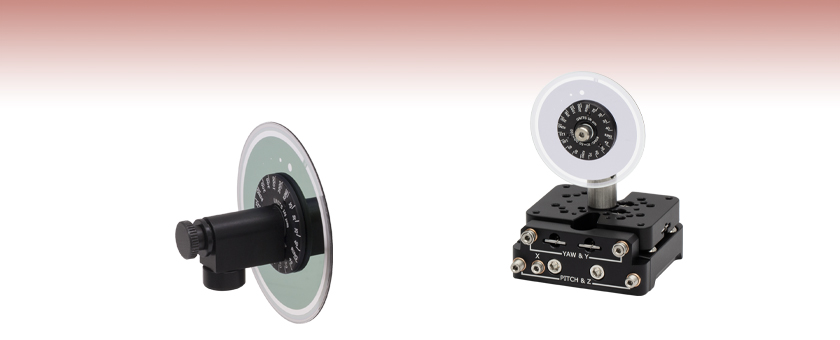
- 16-Position Pinhole Wheel with Hole Sizes from Ø25 µm to Ø2 mm
- Lithographically Etched Chrome on Glass
- AR Coated for 350 - 700 nm on Both Sides
Application Idea
A PHWM16 Pinhole Wheel Post Mounted to a PY005 5-Axis Translation Stage for Alignment
PHWM16
Mounted 16-Position Pinhole Wheel

Please Wait
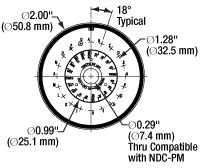
Click to Enlarge
Figure 1.1 インナーリングにはピンホールサイズとアライメント線が刻印されています。
特長
- リソグラフィーエッチングで加工された16個のピンホールが配置されたホイール(透明ガラス製)
- ピンホール径:Ø25 µm~Ø2 mm
- Ø50.8 mm(Ø2インチ)、クロムメッキが施された厚さ0.5 mmのホウケイ酸ガラス製基板
- ポストマウントアセンブリ(NDC-PMが付属(「アセンブリ」タブをご覧ください)
- 両面に350~700 nmのARコーティング付き(Ravg < 0.5%)
こちらのピンホールホイールは、片面にクロムメッキが施されホウケイ酸ガラスのディスク上に、Ø25 µm~Ø2 mmの16個のピンホールがリソグラフィーエッチングされた製品です。放射状に配列されたピンホールにより、実験で様々なピンホールサイズをテストすることができ、ホイール回転後のアライメントも僅かで済みます。当社では、共焦点顕微鏡用に設計された電動ピンホールホイールもご用意しております。
Ø50.8 mm(Ø2インチ)、厚さ0.5 mmのディスクはフォトリソグラフィ技術を用いて作成されており、ピンホールは透明基板上のクロムメッキをエッチングにより除去して形成されています。ホイールの両面には、ホイールの透過率を向上させるために、350~700 nm用のARコーティング(Ravg < 0.5%)が施されています。Delrin®*製のインナーディスクにはピンホールサイズとピンホールの位置を指し示すアライメント用の線が刻印されています。ピンホールのサイズと位置についてはFigure 1.1とTable 1.2をご覧ください。
ピンホールホイールはポストマウントアセンブリNDC-PMの回転軸に取り付けることができ、ポストマウントアセンブリはさらに当社のØ12 mm~Ø12.7 mm(Ø1/2インチ)ポストに取り付けることができます。各ポストマウントアセンブリには、そのために必要なM4取付け穴を有するアダプタが付属します。マウントのシャフトは側面の止めネジ(セットスクリュ)を付属の1.3 mm六角レンチで締め付けることで固定できます。ピンホールホイールをNDC-PMに取り付ける手順については「アセンブリ」タブをご覧ください。
*Delrin®はDupont Polymers社の登録商標です。
| Table 1.2 Pinhole Specifications | |||||
|---|---|---|---|---|---|
| Positiona | Pinhole Size | Position | Pinhole Size | Position | Pinhole Size |
| A | Ø100 µm with Ø50 µm Obstruction | G | Ø50 µm | M | Ø125 µm |
| B | Ø25 µm | H | Ø60 µm | N | Ø200 µm |
| C | Ø30 µm | I | Ø70 µm | O | Ø300 µm |
| D | Ø35 µm | J | Ø80 µm | P | Ø1000 µm |
| E | Ø40 µm | K | Ø90 µm | Q | Ø2000 µm |
| F | Ø45 µm | L | Ø100 µm | - | - |
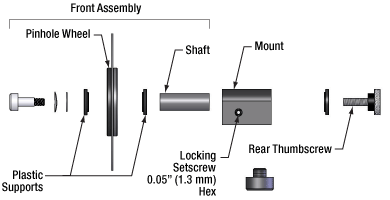
Click to Enlarge
Figure 2.1 PHWM16の分解図
ピンホールホイールの取付け方
16ポジションピンホールホイールは、ポストマウントアセンブリNDC-PMを使用すると、下記の組み立て手順でポストに取り付けることができます。M4取付け穴用アダプタは付属しています。
- アセンブリNDC-PMの側面にある#4-40ロック用止めネジを1.3 mm六角レンチで締め付け、シャフトの位置を固定します。後ろのつまみネジを緩めて外し、ロック用止めネジを緩めます(Figure 2.2)。
- マウントからアセンブリの前部分を引き抜きます(Figure 2.3)。
- アセンブリを縦に持った状態でシャフトのネジを緩めます。上部のプラスチックサポートを取り外し、ピンホールホイールを刻印面が下向きになるようにして置きます。プラスチックサポートを戻し、シャフトをキャップスクリュに締め付けてピンホールホイールを固定します(Figure 2.4)。
- ピンホールホイールがついたアセンブリの前部分を、マウントに取り付けて、ロック用止めネジで固定し、後ろのつまみネジを締め付けます(Figure 2.5)。
取り付け時ならびに使用時のポイント:
- マウントを縦に持つと(Figure 2.4参照)、組み立て時に部品(例:ワッシャ、スペーサ、プラスチックサポートなど)が落ちません。
- ピンホールホイールを固定する際、過度に締め付けるとホイールが割れる場合がありますのでご注意ください。
- ロック用止めネジを完全に締め付けても、ホイールは手で動かそうとすると回転することがあります。
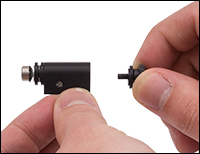
Click to Enlarge
Figure 2.2 マウントを固定し、後ろのつまみネジを取り外します。
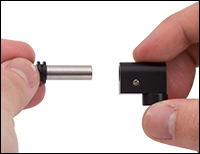
Click to Enlarge
Figure 2.3 マウントの固定を解除し、マウントからアセンブリの前部分(上図のFront Assembly)を引き抜きます。
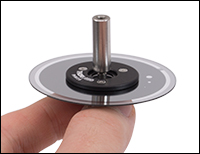
Click to Enlarge
Figure 2.4 ピンホールホイールは垂直に持って固定します。
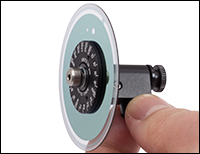
Click to Enlarge
Figure 2.5 アセンブリの前部分をマウントに取り付け、後ろのつまみネジを締め付けます。
空間フィルタの原理
ホログラフィをはじめとする多くの用途において、レーザービームの空間強度が変動することは望ましくありません。空間フィルタ―システムKT311/Mは、きれいで空間的に均一なガウシアンビームを作りだすのに適しています。
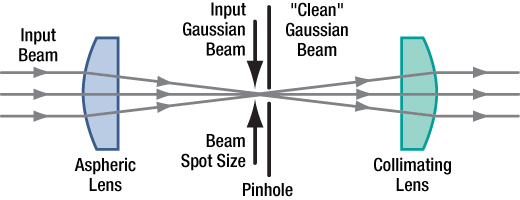
Figure 3.1 空間フィルターシステム
入力ガウシアンビームは、空間的に変動する強度「ノイズ」を有しています。ビームが非球面レンズによって集光される時、入力ビームは中心の(光軸上の)ガウシアンスポットと、望ましくない「ノイズ」(Figure 3.2参照)に対応する干渉稿に変換されます。干渉縞の径方向の位置は「ノイズ」の空間周波数に比例します。
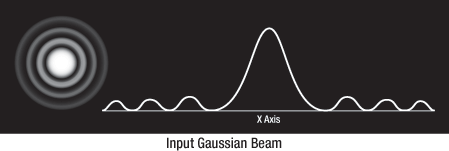
Figure 3.2 入射ガウシアンビーム
ガウシアンスポットの中心にピンホールを配置することによって、ビームのきれいな部分が透過し、干渉縞は遮断されます(Figure 3.3参照)。
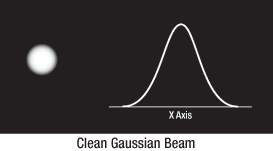
Figure 3.3 クリーンなガウシアンビーム
ビームの出力の99%を含有する位置における回折限界スポットサイズは以下のように与えられます。

ここで、λは波長、ƒは焦点距離、r は1/e2 における入射ビームの半径です。
空間フィルターシステム用の正しい光学素子とピンホールの選択
用途に応じた正しい光学素子とピンホールの選択は、入力波長、光源のビーム径、およびご希望の出射ビーム径に依存します。
例えば、直径(1/e2) 1.2 mmの650 nmの半導体レーザ光源を用いて、希望する空間フィルターシステムの出射ビームの直径が4.4 mmであるとします。これらのパラメータの場合、レーザ光源の直径に十分対応する開口5.1 mmを有して650 nm用に設計されているマウント付き非球面レンズC560TME-Bを空間フィルターシステムの入力側に利用するのが適当と考えられます。
ビームの出力の99%を含有する位置における回折限界のスポットサイズの方程式は上に示しました。そして、この例では、C560TM-Bのλ = (650 x 10-9 m)、f = 13.86 mm、および r = 0.6 mmを代入すると以下のようになります。

回折限界スポットサイズ(光源波長:650 nm、ビーム径:Ø1.2 mm)
ピンホールはDよりもおよそ30%大きいものを選択します。ピンホールが小さすぎるとビームの一部はカットされてしまい、大きすぎるとTEM00以上の成分もピンホールを抜けてしまいます。それ故、この例では19.5 μmのピンホールが適しています。したがって、ピンホールサイズ20 μmのマウント付きピンホールP20Kの利用をお勧めします。ビームウエスト径の変更、およびそれに伴うピンホールサイズ変更のために修正可能なパラメータには、入力ビーム径や集光レンズの焦点距離が含まれます。入力ビーム径が小さくなるとビームウエスト径は大きくなります。焦点距離の長い集光レンズを使用することでもビームウエスト径は大きくなります。
最後に、コリメートしたビーム径が希望の4.4 mmになるように空間フィルタの出力側の光学素子を選択します。レンズの正しい焦点距離を決定するのに、Figure 3.4を考えます(原寸に比例していません)。左側の三角形から角度はおおよそ2.48oであると分かります。右側の三角形に同じ角度を使うと、平凸レンズの焦点距離はおよそ50 mmであることが分かります。

Figure 3.4 Bビーム拡大の例
この焦点距離から、平凸レンズLA1131-B(設計波長633 nmにおいて焦点距離が50 mmですが、光源の波長650 nmにおいても焦点距離はほぼ同じと考えられます)が推奨されます。
注:ビームの拡大率は、出射側の焦点距離を入射側の焦点距離で割ったものと同じです。
もし、出射側の焦点距離として20 mm(AL2520-A、AL2520-B、AL2520-C)が必要である場合には、適切な性能を得るために、大きな直径の非球面レンズを平凸レンズの代わりに使うことができます。これらのレンズは25 mmの直径で、固定リングSM1RRを使って固定できます。
| Table 4.1 Damage Threshold Specifications | |
|---|---|
| Item # | Damage Threshold |
| PHWM16 | 7.5 J/cm2 at 532 nm, 10 ns, 10 Hz, Ø0.491 mm |
当社のピンホールおよびピンホールホイールの損傷閾値データ
Table 4.1の仕様は当社の16ポジションピンホールホイールの測定値です。
レーザによる損傷閾値について
このチュートリアルでは、レーザ損傷閾値がどのように測定され、使用する用途に適切な光学素子の決定にその値をどのようにご利用いただけるかを総括しています。お客様のアプリケーションにおいて、光学素子を選択する際、光学素子のレーザによる損傷閾値(Laser Induced Damage Threshold :LIDT)を知ることが重要です。光学素子のLIDTはお客様が使用するレーザの種類に大きく依存します。連続(CW)レーザは、通常、吸収(コーティングまたは基板における)によって発生する熱によって損傷を引き起こします。一方、パルスレーザは熱的損傷が起こる前に、光学素子の格子構造から電子が引き剥がされることによって損傷を受けます。ここで示すガイドラインは、室温で新品の光学素子を前提としています(つまり、スクラッチ&ディグ仕様内、表面の汚染がないなど)。光学素子の表面に塵などの粒子が付くと、低い閾値で損傷を受ける可能性があります。そのため、光学素子の表面をきれいで埃のない状態に保つことをお勧めします。光学素子のクリーニングについては「光学素子クリーニングチュートリアル」をご参照ください。
テスト方法
当社のLIDTテストは、ISO/DIS 11254およびISO 21254に準拠しています。
初めに、低パワー/エネルギのビームを光学素子に入射します。その光学素子の10ヶ所に1回ずつ、設定した時間(CW)またはパルス数(決められたprf)、レーザを照射します。レーザを照射した後、倍率約100倍の顕微鏡を用いた検査で確認し、すべての確認できる損傷を調べます。特定のパワー/エネルギで損傷のあった場所の数を記録します。次に、そのパワー/エネルギを増やすか減らすかして、光学素子にさらに10ヶ所レーザを照射します。このプロセスを損傷が観測されるまで繰返します。損傷閾値は、光学素子が損傷に耐える、損傷が起こらない最大のパワー/エネルギになります。1つのミラーBB1-E02の試験結果はFigure 37Bのようなヒストグラムになります。
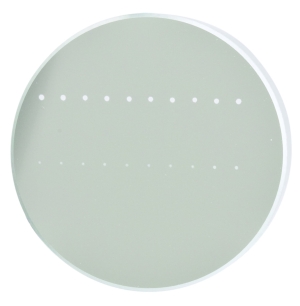
Figure 37A 写真はアルミニウムをコーティングしたミラーでLIDTテストを終えたものです。このテストは、損傷を受ける前のレーザのエネルギは0.43 J/cm2 (1064 nm、10 ns pulse、 10 Hz、Ø1.000 mm)でした。

Figure 37B ミラーBB1-E02のLIDTを決定するために使用した露光のヒストグラム(例)
| Table 37C Example Test Data | |||
|---|---|---|---|
| Fluence | # of Tested Locations | Locations with Damage | Locations Without Damage |
| 1.50 J/cm2 | 10 | 0 | 10 |
| 1.75 J/cm2 | 10 | 0 | 10 |
| 2.00 J/cm2 | 10 | 0 | 10 |
| 2.25 J/cm2 | 10 | 1 | 9 |
| 3.00 J/cm2 | 10 | 1 | 9 |
| 5.00 J/cm2 | 10 | 9 | 1 |
試験結果によれば、ミラーの損傷閾値は 2.00 J/cm2 (532 nm、10 ns pulse、10 Hz、 Ø0.803 mm)でした。尚、汚れや汚染によって光学素子の損傷閾値は大幅に低減されるため、こちらの試験はクリーンな光学素子で行っています。また、特定のロットのコーティングに対してのみ試験を行った結果ではありますが、当社の損傷閾値の仕様は様々な因子を考慮して、実測した値よりも低めに設定されており、全てのコーティングロットに対して適用されています。
CWレーザと長パルスレーザ
光学素子がCWレーザによって損傷を受けるのは、通常バルク材料がレーザのエネルギを吸収することによって引き起こされる溶解、あるいはAR(反射防止)コーティングのダメージによるものです[1]。1 µsを超える長いパルスレーザについてLIDTを論じる時は、CWレーザと同様に扱うことができます。
パルス長が1 nsと1 µs の間のときは、損傷は吸収、もしくは絶縁破壊のどちらかで発生していると考えることができます(CWとパルスのLIDT両方を調べなければなりません)。吸収は光学素子の固有特性によるものか、表面の不均一性によるものかのどちらかによって起こります。従って、LIDTは製造元の仕様以上の表面の質を有する光学素子にのみ有効です。多くの光学素子は、ハイパワーCWレーザで扱うことができる一方、アクロマティック複レンズのような接合レンズやNDフィルタのような高吸収光学素子は低いCWレーザ損傷閾値になる傾向にあります。このような低い損傷閾値は接着剤や金属コーティングにおける吸収や散乱によるものです。
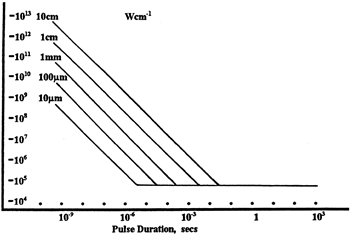
Figure 37D 線形パワー密度におけるLIDTに対するパルス長とスポットサイズ。長パルス~CWでは線形パワー密度はスポットサイズにかかわらず一定です。 このグラフの出典は[1]です。

Figure 37E 均一ビームとガウシアンビームの強度分布プロファイル
繰返し周波数(prf)の高いパルスレーザは、光学素子に熱的損傷も引き起こします。この場合は吸収や熱拡散率のような因子が深く関係しており、残念ながらprfの高いレーザが熱的影響によって光学素子に損傷を引き起こす場合の信頼性のあるLIDTを求める方法は確立されておりません。prfの大きいビームでは、平均出力およびピークパワーの両方を等しいCW出力と比較する必要があります。また、非常に透過率の高い材料では、prfが上昇してもLIDTの減少は皆無かそれに近くなります。
ある光学素子の固有のCWレーザの損傷閾値を使う場合には、以下のことを知る必要があります。
- レーザの波長
- ビーム径(1/e2)
- ビームのおおよその強度プロファイル(ガウシアン型など)
- レーザのパワー密度(トータルパワーをビームの強度が1/e2の範囲の面積で割ったもの)
ビームのパワー密度はW/cmの単位で計算します。この条件下では、出力密度はスポットサイズとは無関係になります。つまり、スポットサイズの変化に合わせてLIDTを計算し直す必要がありません(Figure 37D参照)。平均線形パワー密度は、下の計算式で算出できます。

ここでは、ビーム強度プロファイルは一定であると仮定しています。次に、ビームがホットスポット、または他の不均一な強度プロファイルの場合を考慮して、おおよその最大パワー密度を計算する必要があります。ご参考までに、ガウシアンビームのときはビームの強度が1/e2の2倍のパワー密度を有します(Figure 37E参照)。
次に、光学素子のLIDTの仕様の最大パワー密度を比較しましょう。損傷閾値の測定波長が光学素子に使用する波長と異なっている場合には、その損傷閾値は適宜補正が必要です。おおよその目安として参考にできるのは、損傷閾値は波長に対して比例関係であるということです。短い波長で使う場合、損傷閾値は低下します(つまり、1310 nmで10 W/cmのLIDTならば、655 nmでは5 W/cmと見積もります)。

この目安は一般的な傾向ですが、LIDTと波長の関係を定量的に示すものではありません。例えば、CW用途では、損傷はコーティングや基板の吸収によってより大きく変化し、必ずしも一般的な傾向通りとはなりません。上記の傾向はLIDT値の目安として参考にしていただけますが、LIDTの仕様波長と異なる場合には当社までお問い合わせください。パワー密度が光学素子の補正済みLIDTよりも小さい場合、この光学素子は目的の用途にご使用いただけます。
当社のウェブ上の損傷閾値の仕様と我々が行った実際の実験の値の間にはある程度の差があります。これはロット間の違いによって発生する誤差を許容するためです。ご要求に応じて、当社は個別の情報やテスト結果の証明書を発行することもできます。損傷解析は、類似した光学素子を用いて行います(お客様の光学素子には損傷は与えません)。試験の費用や所要時間などの詳細は、当社までお問い合わせください。
パルスレーザ
先に述べたように、通常、パルスレーザはCWレーザとは異なるタイプの損傷を光学素子に引き起こします。パルスレーザは損傷を与えるほど光学素子を加熱しませんが、光学素子から電子をひきはがします。残念ながら、お客様のレーザに対して光学素子のLIDTの仕様を照らし合わせることは非常に困難です。パルスレーザのパルス幅に起因する光学素子の損傷には、複数の形態があります。Table 37Fのハイライトされた列は当社の仕様のLIDT値が当てはまるパルス幅に対する概要です。
パルス幅が10-9 sより短いパルスについては、当社の仕様のLIDT値と比較することは困難です。この超短パルスでは、多光子アバランシェ電離などのさまざまなメカニクスが損傷機構の主流になります[2]。対照的に、パルス幅が10-7 sと10-4 sの間のパルスは絶縁破壊、または熱的影響により光学素子の損傷を引き起こすと考えられます。これは、光学素子がお客様の用途に適しているかどうかを決定するために、レーザービームに対してCWとパルス両方による損傷閾値を参照しなくてはならないということです。
| Table 37F Laser Induced Damage Regimes | ||||
|---|---|---|---|---|
| Pulse Duration | t < 10-9 s | 10-9 < t < 10-7 s | 10-7 < t < 10-4 s | t > 10-4 s |
| Damage Mechanism | Avalanche Ionization | Dielectric Breakdown | Dielectric Breakdown or Thermal | Thermal |
| Relevant Damage Specification | No Comparison (See Above) | Pulsed | Pulsed and CW | CW |
お客様のパルスレーザに対してLIDTを比較する際は、以下のことを確認いただくことが重要です。
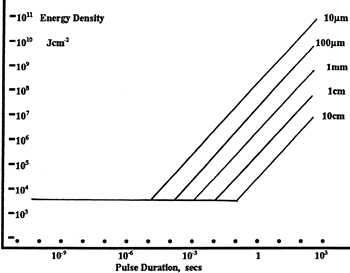
Figure 37G エネルギ密度におけるLIDTに対するパルス長&スポットサイズ。短パルスでは、エネルギ密度はスポットサイズにかかわらず一定です。このグラフの出典は[1]です。
- レーザの波長
- ビームのエネルギ密度(トータルエネルギをビームの強度が1/e2の範囲の面積で割ったもの)
- レーザのパルス幅
- パルスの繰返周波数(prf)
- 実際に使用するビーム径(1/e2 )
- ビームのおおよその強度プロファイル(ガウシアン型など)
ビームのエネルギ密度はJ/cm2の単位で計算します。Figure 37Gは、短パルス光源には、エネルギ密度が適した測定量であることを示しています。この条件下では、エネルギ密度はスポットサイズとは無関係になります。つまり、スポットサイズの変化に合わせてLIDTを計算し直す必要がありません。ここでは、ビーム強度プロファイルは一定であると仮定しています。ここで、ビームがホットスポット、または他の不均一な強度プロファイルの場合を考慮して、おおよその最大パワー密度を計算する必要があります。ご参考までに、ガウシアンビームのときは一般にビームの強度が1/e2のときの2倍のパワー密度を有します。
次に、光学素子のLIDTの仕様と最大エネルギ密度を比較しましょう。損傷閾値の測定波長が光学素子に使用する波長と異なっている場合には、その損傷閾値は適宜補正が必要です[3]。経験則から、損傷閾値は波長に対して以下のような平方根の関係であるということです。短い波長で使う場合、損傷閾値は低下します(例えば、1064 nmで 1 J/cm2のLIDTならば、532 nmでは0.7 J/cm2と計算されます)。

波長を補正したエネルギ密度を得ました。これを以下のステップで使用します。
ビーム径は損傷閾値を比較する時にも重要です。LIDTがJ/cm2の単位で表される場合、スポットサイズとは無関係になりますが、ビームサイズが大きい場合、LIDTの不一致を引き起こす原因でもある不具合が、より明らかになる傾向があります[4]。ここで示されているデータでは、LIDTの測定には<1 mmのビーム径が用いられています。ビーム径が5 mmよりも大きい場合、前述のようにビームのサイズが大きいほど不具合の影響が大きくなるため、LIDT (J/cm2)はビーム径とは無関係にはなりません。
次に、パルス幅について補正します。パルス幅が長くなるほど、より大きなエネルギに光学素子は耐えることができます。パルス幅が1~100 nsの場合の近似式は以下のようになります。

お客様のレーザのパルス幅をもとに、光学素子の補正されたLIDTを計算するのにこの計算式を使います。お客様の最大エネルギ密度が、この補正したエネルギ密度よりも小さい場合、その光学素子はお客様の用途でご使用いただけます。ご注意いただきたい点は、10-9 s と10-7 sの間のパルスにのみこの計算が使えることです。パルス幅が10-7 sと10-4 sの間の場合には、CWのLIDTも調べなければなりません。
当社のウェブ上の損傷閾値の仕様と我々が行った実際の実験の値の間にはある程度の差があります。これはロット間の違いによって発生する誤差を許容するためです。ご要求に応じて、当社では個別のテスト情報やテスト結果の証明書を発行することも可能です。詳細は、当社までお問い合わせください。
[1] R. M. Wood, Optics and Laser Tech. 29, 517 (1998).
[2] Roger M. Wood, Laser-Induced Damage of Optical Materials (Institute of Physics Publishing, Philadelphia, PA, 2003).
[3] C. W. Carr et al., Phys. Rev. Lett. 91, 127402 (2003).
[4] N. Bloembergen, Appl. Opt. 12, 661 (1973).
レーザーシステムが光学素子に損傷を引き起こすかどうか判断するプロセスを説明するために、レーザによって引き起こされる損傷閾値(LIDT)の計算例をいくつかご紹介します。同様の計算を実行したい場合には、右のボタンをクリックしてください。計算ができるスプレッドシートをダウンロードいただけます。ご使用の際には光学素子のLIDTの値と、レーザーシステムの関連パラメータを緑の枠内に入力してください。スプレッドシートでCWならびにパルスの線形パワー密度、ならびにパルスのエネルギ密度を計算できます。これらの値はスケーリング則に基づいて、光学素子のLIDTの調整スケール値を計算するのに用いられます。計算式はガウシアンビームのプロファイルを想定しているため、ほかのビーム形状(均一ビームなど)には補正係数を導入する必要があります。 LIDTのスケーリング則は経験則に基づいていますので、確度は保証されません。なお、光学素子やコーティングに吸収があると、スペクトル領域によってLIDTが著しく低くなる場合があります。LIDTはパルス幅が1ナノ秒(ns)未満の超短パルスには有効ではありません。

Figure 71A ガウシアンビームの最大強度は均一ビームの約2倍です。
CWレーザの例
波長1319 nm、ビーム径(1/e2)10 mm、パワー0.5 Wのガウシアンビームを生成するCWレーザーシステム想定します。このビームの平均線形パワー密度は、全パワーをビーム径で単純に割ると0.5 W/cmとなります。

しかし、ガウシアンビームの最大パワー密度は均一ビームの約2倍です(Figure 71A参照)。従って、システムのより正確な最大線形パワー密度は1 W/cmとなります。
アクロマティック複レンズAC127-030-CのCW LIDTは、1550 nmでテストされて350 W/cmとされています。CWの損傷閾値は通常レーザ光源の波長に直接スケーリングするため、LIDTの調整値は以下のように求められます。

LIDTの調整値は350 W/cm x (1319 nm / 1550 nm) = 298 W/cmと得られ、計算したレーザーシステムのパワー密度よりも大幅に高いため、この複レンズをこの用途に使用しても安全です。
ナノ秒パルスレーザの例:パルス幅が異なる場合のスケーリング
出力が繰返し周波数10 Hz、波長355 nm、エネルギ1 J、パルス幅2 ns、ビーム径(1/e2)1.9 cmのガウシアンビームであるNd:YAGパルスレーザーシステムを想定します。各パルスの平均エネルギ密度は、パルスエネルギをビームの断面積で割って求めます。

上で説明したように、ガウシアンビームの最大エネルギ密度は平均エネルギ密度の約2倍です。よって、このビームの最大エネルギ密度は約0.7 J/cm2です。
このビームのエネルギ密度を、広帯域誘電体ミラーBB1-E01のLIDT 1 J/cm2、そしてNd:YAGレーザーラインミラーNB1-K08のLIDT 3.5 J/cm2と比較します。LIDTの値は両方とも、波長355 nm、パルス幅10 ns、繰返し周波数10 Hzのレーザで計測しました。従って、より短いパルス幅に対する調整を行う必要があります。 1つ前のタブで説明したようにナノ秒パルスシステムのLIDTは、パルス幅の平方根にスケーリングします:

この調整係数により広帯域誘電体ミラーBB1-E01のLIDTは0.45 J/cm2に、Nd:YAGレーザーラインミラーのLIDTは1.6 J/cm2になり、これらをビームの最大エネルギ密度0.7 J/cm2と比較します。広帯域ミラーはレーザによって損傷を受ける可能性があり、より特化されたレーザーラインミラーがこのシステムには適していることが分かります。
ナノ秒パルスレーザの例:波長が異なる場合のスケーリング
波長1064 nm、繰返し周波数2.5 Hz、パルスエネルギ100 mJ、パルス幅10 ns、ビーム径(1/e2)16 mmのレーザ光を、NDフィルタで減衰させるようなパルスレーザーシステムを想定します。これらの数値からガウシアン出力における最大エネルギ密度は0.1 J/cm2になります。Ø25 mm、OD 1.0の反射型NDフィルタ NDUV10Aの損傷閾値は355 nm、10 nsのパルスにおいて0.05 J/cm2で、同様の吸収型フィルタ NE10Aの損傷閾値は532 nm、10 nsのパルスにおいて10 J/cm2です。1つ前のタブで説明したように光学素子のLIDTは、ナノ秒パルス領域では波長の平方根にスケーリングします。

スケーリングによりLIDTの調整値は反射型フィルタでは0.08 J/cm2、吸収型フィルタでは14 J/cm2となります。このケースでは吸収型フィルタが光学損傷を防ぐには適した選択肢となります。
マイクロ秒パルスレーザの例
パルス幅1 µs、パルスエネルギ150 µJ、繰返し周波数50 kHzで、結果的にデューティーサイクルが5%になるレーザーシステムについて考えてみます。このシステムはCWとパルスレーザの間の領域にあり、どちらのメカニズムでも光学素子に損傷を招く可能性があります。レーザーシステムの安全な動作のためにはCWとパルス両方のLIDTをレーザーシステムの特性と比較する必要があります。
この比較的長いパルス幅のレーザが、波長980 nm、ビーム径(1/e2)12.7 mmのガウシアンビームであった場合、線形パワー密度は5.9 W/cm、1パルスのエネルギ密度は1.2 x 10-4 J/cm2となります。これをポリマーゼロオーダ1/4波長板WPQ10E-980のLIDTと比較してみます。CW放射に対するLIDTは810 nmで5 W/cm、10 nsパルスのLIDTは810 nmで5 J/cm2です。前述同様、光学素子のCW LIDTはレーザ波長と線形にスケーリングするので、CWの調整値は980 nmで6 W/cmとなります。一方でパルスのLIDTはレーザ波長の平方根とパルス幅の平方根にスケーリングしますので、1 µsパルスの980 nmでの調整値は55 J/cm2です。光学素子のパルスのLIDTはパルスレーザのエネルギ密度よりはるかに大きいので、個々のパルスが波長板を損傷することはありません。しかしレーザの平均線形パワー密度が大きいため、高出力CWビームのように光学素子に熱的損傷を引き起こす可能性があります。
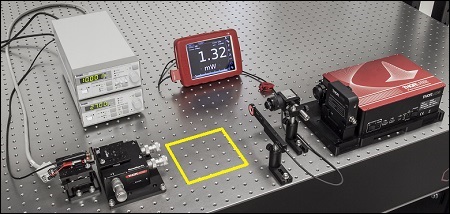
Click to Enlarge
Figure 168A 実験セットアップ上の黄色い四角で囲まれたエリアにビーム円形化システムを設置
楕円ビームの円形化技術の比較
端面発光型半導体レーザは、発光開口部の断面が長方形になっているため、楕円形のビームを出射します。開口部の短辺から出射されるビーム成分は、これに直交するビーム成分よりも大きな広がり角を有します。一方のビーム成分がもう一方よりも大きく拡散するため、ビームの形状は円形ではなく楕円形になります。
楕円形のビーム形状は、円形のビームよりも集光ビームのスポットサイズが大きいことで放射照度(面積あたりのパワー)が低くなってしまいます。楕円ビームを円形化する技術は複数ありますが、ここではシリンドリカルレンズ、アナモルフィックプリズムのペア、空間フィルタを利用した3種類の方法で実験を行い性能を比較しています。 円形化されたビームの特性は、M2測定、波面測定、伝送パワー測定によって評価しました。
これらの円形化技術によって楕円形の入射ビームの真円度は向上しますが、それぞれの技術ごとに円形化やビーム品質および伝送パワーの特性が異なることを示しました。この「実験データ」タブ内に記載されている結果から、用途に必要な要件を満たした円形化技術を選択するべきである事がわかりました。
実験の設計とセットアップ
この実験セットアップはFigure 168Aの写真で示されています。 Figure 168B~168Dでは温度制御された670 nm半導体レーザからの楕円コリメート光をそれぞれの円形化システムに入射させています。コリメートにより、広がり角は小さくなりますが、ビーム形状はレーザ出力時と変わりません。各システムは下記の光学系をベースに構成されています。
- 平凸シリンドリカルレンズLJ1874L2-AおよびLJ1638L1-A(Figure 168B)
- マウント無しアナモルフィックプリズムペアPS873-A(Figure 168C)
- 空間フィルターシステムKT310(旧製品)および Ø5 µm ピンホールP5S(旧製品)(Figure 168D)
ビーム円形化システム(Figure 168B~168D参照)を黄色い四角で囲まれた空きスペースに1台ずつ設置しました。このようにすることでそれぞれの円形化技術を同じ実験条件で評価できるため、実験結果を直接比較することができます。この実験上の制約により取り付け方法も制約されるため、コンパクト化という点では最適化されていません。またアナモルフィックプリズムペアについても、より便利で光学的にも調整されたマウント済みの製品を使わずに、マウント無しの製品を用いています。
それぞれの円形化システムから出射されたビームの特性は、パワーメータ、波面センサならびにM2システムを使用して測定を行い、評価されました。例示目的のため、実験セットアップのFigure 168Aでは、テーブルの右側に、これらの評価機器がすべて表示されていますが、評価は1種類ずつ行います。パワーメータは、ビーム円形化システムが入射ビームの強度をどの位減衰させるのかを測定するために使用します。波面センサは、出射ビームの収差を測定するために使用します。M2システムは出力ビームのビーム品質(理想のガウシアンビームからの劣化具合)の測定に使用します。円形化システムはレーザービームの減衰もされず、収差も生じず、完全なガウシアンビームを出射することが理想的です。
端面発光型半導体レーザからの発光には非点隔差があるため、直交するビーム成分の変位した焦点をオーバーラップで望ましい形状が得られます。ここで調査している3種類の円形化技術のうち、シリンドリカルレンズペアのみが非点収差も補償することができます。直交するビーム成分の焦点間の変位はこれらすべての円形化技術で測定できます。シリンドリカルレンズペアの場合、構成を調整することでレーザービーム内の非点収差を最小限に抑えます。この非点収差は規格化しています。
実験結果
実験結果をTable 168Eにまとめています。緑色のセルは各カテゴリ内における最も良い結果を示しています。円形化の方法にはそれぞれの利点があります。用途に最適な円形化技術は、ビーム品質、伝送パワー、セットアップの制約に対するシステムの要件によって決まります。
空間フィルタは真円度とビーム品質を著しく向上させますが、ビームの伝送パワーは低くなります。シリンドリカルレンズペアは、伝送ビームを綺麗な円形にし、バランスの良い円形およびビーム品質を実現します。また、シリンドリカルレンズペアはビームの非点収差のほとんどを補償します。アナモルフィックプリズムペアによるビームの真円度はシリンドリカルレンズペアによる真円度と比較しても遜色ありません。シリンドリカルレンズと比較して、プリズムからの出力ビームのM2値は小さく、波面誤差は少なくなりますが、伝送パワーはやや低くなります。
| Table 168E Experimental Results | ||||||
|---|---|---|---|---|---|---|
| Method | Beam Intensity Profile | Circularitya | M2 Values | RMS Wavefront | Transmitted Power | Normalized Astigmatismb |
| Collimated Source Output (No Circularization Technique) |  Click to Enlarge Scale in Microns | 0.36 | Y Axis: 1.63 | 0.17 | Not Applicable | 0.67 |
| Cylindrical Lens Pair |  Click to Enlarge Scale in Microns | 0.84 | X Axis: 1.90 Y Axis: 1.93 | 0.30 | 91% | 0.06 |
| Anamorphic Prism Pair |  Click to Enlarge Scale in Microns | 0.82 | X Axis: 1.60 Y Axis: 1.46 | 0.16 | 80% | 1.25 |
| Spatial Filter |  Click to Enlarge Scale in Microns | 0.93 | X Axis: 1.05 Y Axis: 1.10 | 0.10 | 34% | 0.36 |
円形化システムに使用されている部品は、同じ実験セットアップで全ての実験を行えるように選択されています。これにより、全ての円形化技術を直接比較することができます。ただし、円形化システムのセットアップを個別に最適化した方が性能は向上します。コリメートレンズおよびアナモルフィックプリズムペア用のマウントを使用すると、操作や実験システムへの取り付けが簡単に行えます。小型のマウントを使用して、それぞれのペア同士をより精密に設置して、実験結果を向上させることもできます。 また、焦点距離をカスタマイズした受注生産品のシリンドリカルレンズを使用して、シリンドリカルレンズペアの円形化システムの実験結果を向上させることもできます。ビームプロファイルソフトウェアのアルゴリズムを用いて、真円度の計算に使用するビーム半径を決定すると、全ての実験結果に影響を与えます。
追加情報
この実験で使用したコンポーネントの選択および構築方法についての情報は、下記のリンクをクリックしてご覧いただけます。
| Posted Comments: | |
CHRISTIAN OLLIER
(posted 2024-07-01 05:49:06.027) Quelle est la précision sur le diamètre des trous?
Cordialement,
C.OLLIER. jdelia
(posted 2024-07-22 04:09:32.0) Thank you for reaching out. Translation: "How accurate is the diameter of the holes?" We unfortunately do not have diameter tolerances listed for these holes, however if you could provide a tolerance requirement you may have, we could look into whether this product would be suitable. I have reached out to you directly via email to discuss this further. Hyun Min Park
(posted 2022-03-28 16:31:44.94) Hello.
I want to check 2 things. Is that proper to fix pinhole to center of c mount(structure will be c mount-pinhole wheel-c mount). which kind of material are you using for pinhole.
Thank you. jdelia
(posted 2022-04-06 03:07:31.0) Thank you for contacting Thorlabs. The pinhole itself is made out of a chrome-plated fused silica substrate. We unfortunately do not have a good way to incorporate this into a C-mount system, as these are generally intended for free space applications. Atticus Russell
(posted 2020-07-17 16:43:28.97) I think the solidworks file for the P200D is broken YLohia
(posted 2020-08-24 01:37:50.0) Hello Atticus, thank you for contacting Thorlabs. I had reached out to you via email at the time of your initial feedback post, but I did not hear back from you. Could you please explain in what sense the Solidworks file is broken? I'm able to open it just fine. Does this link work for you: https://www.thorlabs.com/_sd.cfm?fileName=TTN164154-E0W.sldprt&partNumber=P200D? If it does not, please try using the STEP file: https://www.thorlabs.com/_sd.cfm?fileName=TTN164154-E0W.step&partNumber=P200D 邹 波
(posted 2020-05-28 17:57:10.377) 针孔外围的黑色氧化膜的BRDF特性是什么样的? YLohia
(posted 2020-05-28 04:27:30.0) Thank you for contacting Thorlabs. An Applications Engineer from our team in China will reach out to you directly. Kevin Sweeney
(posted 2020-02-12 14:10:55.977) How thick is the foil in the P5D? Thank you, llamb
(posted 2020-02-12 05:54:23.0) The foil from the P5D is 50 µm thick. The P5D pinhole sits inside a 40 µm deep counterbore within the foil, bringing the effective pinhole thickness down to 10 µm. user
(posted 2019-11-12 01:25:01.53) Hello. Can I purchase blank-foil-mounted disks? I want to purchase disks without a pinhole at the center.
Best regards, Sang. llamb
(posted 2019-11-13 05:26:22.0) Thank you for contacting Thorlabs. Blank mounted pinhole foils should indeed be feasible. We will reach out to you directly for this case. You may contact us at techsupport@thorlabs.com directly for any future quote requests. Sungjae Lee
(posted 2019-11-11 23:51:54.007) Which model number is possible to fit the Spatial Filter System(KT310/M)?? YLohia
(posted 2019-11-12 11:49:51.0) Hello, any of the 1" diameter lenses can be used. Please see the "Tutorial" tab on the KT310/M page for more information. Timothy Murray
(posted 2019-10-23 06:09:03.907) Unable to obtain ROHS sheet for this item YLohia
(posted 2019-10-23 08:40:57.0) Thank you for contacting Thorlabs. We will reach out to you directly with this information. Philippe Barate
(posted 2019-09-23 06:51:12.69) We need a precise position of the pinhole in a 1" tube and so for multiple pinhole. Is it possible to have the pinhole with an external thread for the mounting and always at the same position if we change the pinhole ? YLohia
(posted 2019-09-24 09:52:20.0) Hello, thank you for contacting Thorlabs. Due to the tolerances of the threads, pinhole mounting, and centration, this is not something that would be repeatable between multiple pinholes. We recommend looking into the MPH16 motorized pinhole wheel for applications that require high repeatability for pinhole switching. Jean-Baptiste Le Bouquin
(posted 2019-06-11 08:57:12.847) We just bought a P5D and cannot make light goes through the hole. When imaging the pinhole plane, one can see a ~100um structure. Could it be that some dust particule has been trapped in the pinhole ? What would be the recommended procedure ? Gently blow some air ? Thanks. llamb
(posted 2019-06-11 01:24:48.0) Thank you for contacting Thorlabs. Using a gentle burst of air is indeed recommended for clearing pinholes. However, it would be useful to see how you are imaging your pinhole. I have reached out to you directly to troubleshoot further. mathieu.guilhem
(posted 2019-02-07 16:30:21.903) Hello,
What's the thickness at aperture of the non-high-power pinholes, such as P10D and P20D ?
Thanks, llamb
(posted 2019-02-07 04:54:14.0) Thank you for your feedback. For these pinholes, the foil substrate as a whole is about 50 µm thick. The actual aperture sits inside a ~40 µm deep counterbore in the center of the foil substrate, making the effective pinhole thickness at the aperture ~10 µm. jos.grooteschaarsberg
(posted 2017-09-25 07:48:16.673) I am missing pinhole position / mount diameter tolerances for assembly of the pinhole in its mount. For exchanging the diameter, I need to know if the new pinhole in its mount is within 20 micrometer at the same centre. nbayconich
(posted 2017-10-03 05:13:38.0) Thank you for contacting Thorlabs. The positional tolerance of the pinhole is ±0.006". I will reach out to you directly. ramin.beravat
(posted 2017-04-06 17:28:23.177) Dear Sir or Madame. Can I get an annular triangle aperture? How thin can the plate be made? The thinner, the better.
Thank you very much. jlow
(posted 2017-04-17 11:27:55.0) Response from Jeremy at Thorlabs: We will contact you directly to quote this. himanaka
(posted 2016-10-26 14:13:54.867) I wonder if you have pinholes mounted on 1/2" disk? tfrisch
(posted 2016-10-31 03:16:29.0) Hello, I will contact you directly with more information on our custom capabilities. david.panak
(posted 2016-09-12 16:19:43.533) Can I get a 100 and a 200 um gold pinhole (P100C and P200C ?)
Please quote price and availability
thanks
David Panak
L-3 Greenville TX tfrisch
(posted 2016-09-15 01:32:59.0) Hello, thank you for contacting Thorlabs. I've asked our Tech Support team to prepare a quote for these custom pinholes for you. martins
(posted 2016-07-04 14:02:40.383) Hello, I purchased a pinhole P15S two months ago. After not being able to get a clean Gaussian beam, I looked at the pinhole with an electron microscope. I found that the hole is partially filled by an unknown and unwanted structure that blocks the laser beam (I can provide the corresponding images). Is there any simple way how to clean the pinhole or should I contact your Support Center to ask for replacement? Thank You. matthieu.leibovici
(posted 2016-05-06 21:09:53.357) Hi, I purchased two P10C 10um high-power precision pinholes last month. After not being able to get a clean Gaussian beam with both, I looked at the pinhole with a microscope and it looks like the diameter does not match the specs, the hole is >15um. I then imaged and tried with a P10S. The P10S pinhole looks good under microscope and I got a clean beam. Have you had a bad batch of P10C? Thanks besembeson
(posted 2016-05-10 02:56:03.0) Response from Bweh at Thorlabs USA: It is possible that you may have a unit that is out of specifications. We would also be curious to know how you determined the >15um diameter. I will contact you. tsangtimothy
(posted 2015-12-17 16:23:14.967) Am I able to purchase an unmounted one? jlow
(posted 2015-12-17 08:52:33.0) Response from Jeremy at Thorlabs: It's generally easier to use a tweezer to take out the retaining ring and get the aperture disk out. We can also provide this unmounted a special. Please contact Techsupport@thorlabs.com to inquire about the special. user
(posted 2015-12-10 10:37:33.84) Why the damage threshold is not mentioned for precision pinholes? besembeson
(posted 2015-12-10 10:32:07.0) Response from Bweh at Thorabs USA: The damage threshold guide for CW will be ~2-4 W/mm^2, 10.6um and for pulses will ~150-250KW/mm^2, 700nm, 10ns. We will be adding these values to the website subsequently. We also have a useful guide at the following link that guides you on how to adjust these values for other laser conditions: http://www.thorlabs.com/newgrouppage9.cfm?objectgroup_id=9025&tabname=Damage%20Thresholds mikhail.alekhin
(posted 2015-11-24 08:45:44.477) Hello. I want to buy a High-Power Precision Pinhole for spatial filter to convert square to Gaussian beam profile for 650 nm 1 W cw-laser.
With the threshold of 10^4 W/mm2, CW @ 10.6 µm it seems like I am on a safe side with 25 and 50 um pinholes. But I have two questions:
1) Is this threshold for "noisy" Gaussian to pure Gaussian conversion, or any-profile to Gaussian conversion. In the latter case, the pinhole, serving as a spatial filter, might absorb >50% of incident laser power.
2) 10^4 W/mm2 is measured for 10.6 µm wavelength, right? Is the threshold the same for 650 nm?
Best regards besembeson
(posted 2015-12-02 10:58:26.0) Response from Bweh at Thorlabs USA: The damage threshold is for a Gaussian beam profile. The threshold will not be the same for 650nm, which is more energetic. The value there will be reduced by a factor equivalent to the ratio of your wavelength to the specified wavelength for the damage threshold, or 0.06 (see the "Damage Threshold" tab at the following link for further details on this estimate:
http://www.thorlabs.com/newgrouppage9.cfm?objectgroup_id=3279). So the damage threshold to use for your laser is about 6 x 10^2 W/mm^2 which is lower than what you would need which means this may not be suitable for your application. michael.roth
(posted 2015-08-13 16:46:41.907) Hello,
can you tell me how much power these foils can absorb? In my application the power density is not very hight, but a large amount of the power will be absorbed (several watts).
Kind regards besembeson
(posted 2015-09-25 09:30:25.0) Response from Bweh at Thorlabs USA: The standard pinhole is made from stainless steel with a black copper oxide plating on both sides. The estimated CW damage threshold is in the order of 100kW/cm^2. We have damage threshold guides for the high power pinholes on the website. nettels
(posted 2015-02-18 17:03:56.423) To what precision are the pinholes centered in the 1' mount?
Thank you.
Daniel cdaly
(posted 2015-02-24 04:57:06.0) Response from Chris at Thorlabs: While the tolerances on the centration of the mount and the internal foil are quite good, the foil sits in the mount somewhat loosely, so the overall centration is really not well defined. If a well tolerances position on the pinhole is needed, we can have the foil epoxied into the mount before cutting as a custom. Any requests for these items should come to us at techsupport@thorlabs.com. carlos.macias
(posted 2015-01-26 11:42:19.607) We bought a few of your high power pinholes (P50C) to build a spatial filter for our femtosecond laser (150 fs, 1030 nm). The quoted threshold for a 10 ns pulse @ 700 nm is 100 MW/cm2. We are focusing our laser to a spot diameter of 65 µm with 1 W of power. So we have an irradiance of ~0.04 MW/cm2. To take into account the difference in pulse durations and wavelength, we use a factor of ~200. Then the supposed damage threshold of the pinhole should be around 0.5 MW/cm2. This is still one order of magnitude larger than our irradiance. So the pinholes worked fine for a couple of days and after the second day, they were all destroyed. We made sure that the pinholes were aligned correctly using low powers (50 mW), before increasing te power to 1 W. Could you then explain why all of the four pinholes we bought did not support the irradiance after two days? Heat slowly destroyed the gold plating? Would it be possible to produce pinholes that would work for us? cdaly
(posted 2015-01-29 09:09:37.0) Response from Chris at Thorlabs: I'm afraid we do not have a spec for the damage threshold of the pinhole for femto-second pulses. Pulses shorter than 10^-9 s cannot be compared to our specified LIDT values with much reliability. In this ultra-short-pulse regime various mechanics, such as multiphoton-avalanche ionization, take over as the predominate damage mechanism. In contrast, pulses between 10^-7 s and 10^-4 s may cause damage to an optic either because of dielectric breakdown or thermal effects. bruno.tremblay
(posted 2015-01-08 12:27:37.747) I experience problem with my two 5µm pinhole.
I notice that after 5 years, light intensity ratio going through a 10µm pinhole relative to 25µm pinhole stayed the same.
But for a 5 µm pinhole relative to the 10µm pinhole, the ratio change by -30% in one case and -50% for the second one.
Is there some long term stability issue which could make that situation normal for small pinhole?
Regards
Bruno cdaly
(posted 2015-01-20 03:34:27.0) Response from Chris at Thorlabs: This is not something we have ever seen before, but we will contact you directly to discuss this further. araf
(posted 2014-03-27 11:04:34.9) Hi,
Could these be made with half inch outermost diameters (SM05/16mm cage compatible)? I'm wishing to perform spatial filtering, but I want to have things as compact as possible. I would also like to utilize the shorter focal length half-inch lenses.
Thanks! jlow
(posted 2014-03-27 11:24:25.0) Response from Jeremy at Thorlabs: We can provide these pinholes in Ø1/2" package as a custom. We will contact you directly for the quote. scienc2
(posted 2014-03-18 14:17:46.877) Hello,
Can you customize a pinhole product that have two pinholes with different sizes on one pinhole product? Also, can you provide the pinhole product without any housing?
Thank you.
Best regards,
Kim, Juwan jlow
(posted 2014-03-18 08:59:38.0) Response from Jeremy at Thorlabs: We can do custom pinholes. We will contact you directly about this. makarov
(posted 2014-02-03 20:51:22.433) Can you estimate damage threshold for CW light (at 808 nm or at 700 nm) for standard non-high-power pinhole? jlow
(posted 2014-02-04 03:08:09.0) Response from Jeremy at Thorlabs: The standard pinhole is made from stainless steel with a black copper oxide plating on both sides. The estimated CW damage threshold is on the order of 100kW/cm^2. l.gerencser
(posted 2013-05-06 12:54:59.367) Could you provide me any information about the damage threshold of the standard (non high power) variant of the precision pinholes for the following laser parameters?
700 nm, 140 fs pulse width, 80 Mhz repetition rate jlow
(posted 2013-05-09 15:49:00.0) Response from Jeremy at Thorlabs: We do not have a spec for the damage threshold of the pinhole for femto-second pulses. For a 10ns pulse at 700nm, the damage threshold is estimated to be around 150kW/mm^2. ihyun2010
(posted 2013-04-15 00:22:30.093) I want to make pinhole like P20S with 3 lows and 3 columns. How can I contact you for this item? tcohen
(posted 2013-04-18 15:19:00.0) Response from Tim at Thorlabs: Thank you for your inquiry. We can assist with customs through our technical support department at techsupport@thorlabs.com. I will contact you directly to discuss this. tcohen
(posted 2012-10-04 13:23:00.0) Response from Tim at Thorlabs: The damage thresholds for the high-power C series are specified with the gold plated side incident. The standard S series are on the order of 100kW/mm^2 for 10ns, 700nm. user
(posted 2012-10-03 13:35:09.0) What is the damage threshold of the mounted pinholes (S-series)? As for the high-power (C-series) ones, which side is facing the laser beam (the catalog page is slightly controversial)? bdada
(posted 2011-09-22 20:32:00.0) Response from Buki at Thorlabs:
We do not have exactly what you are looking for but we have submitted your request to our design team. In the meantime, please consider if our zero aperture iris, SM1D12SZ, may be suitable for your application. We also have variable iris diaphraphms:
http://www.thorlabs.com/NewGroupPage9.cfm?ObjectGroup_ID=1479
http://www.thorlabs.com/NewGroupPage9.cfm?ObjectGroup_ID=220 akde
(posted 2011-09-13 00:44:03.0) I used the cage system to construct a fluorescence microscope for single-molecule detection. I found the parasitic light is a source of huge noise in the system. The cage components may be colored black to prevent this. Better light isolation may be achieved by using a tube system where all optics (lenses, apertures etc) may be mounted inside a tube to result in robust alignment as well. Presently I am using a combination of cages and tubes.
Dr Arijit K De (Postdoc, LBNL/UCBerkeley) akde
(posted 2011-09-13 00:36:41.0) For few specific applications, e.g. spatial filtering in confocal fluorescence detection etc, larger apertures (>150um) are often needed as a smaller pinhole reduces the signal level in addition to background rejection. A series of such apertures with varying sizes (200um, 500um & 1mm) on a 1" sm1 mount will be of great interest. jjurado
(posted 2011-07-22 10:30:00.0) Response from Javier at Thorlabs to valeri.abrahamyan: Thank you very much for your interest in our products. To purchase our products, you can contact us at sales@thorlabs.com or by phone at (973) 579 7227. You can also create an account with us online and purchase our products through the web. You can create your own account here:
http://www.thorlabs.com/login.cfm?lc=create
I will contact you directly for further assistance. valeri.abrahamyan
(posted 2011-07-21 17:13:08.0) I wont to purchase your praducts jjurado
(posted 2011-07-19 18:16:00.0) Response from Javier at Thorlabs to cmansfield: Thank you very much for contacting us. We can certainly offer a 200 um mounted pinhole. I will contact you directly with a quotation. cmansfield
(posted 2011-07-19 12:32:04.0) Do you have a 200 um mounted pinhole?
Can you make one if not?
I would rather not buy the 3/8" Diameter pinhole from Edmund. Thorlabs
(posted 2010-10-27 17:00:59.0) Response from Javier at Thorlabs to Ron Palfenier: the outer diameter of the unmounted pinhole is 0.375" (9.53mm). ron.palfenier
(posted 2010-10-27 12:02:50.0) If the pinhole were removed from the 1 inch holder, what would be the O.D. size of the un-mounted pinhole? klee
(posted 2009-09-08 12:04:21.0) A response from Ken at Thorlabs to wwarger: We can make 1/2" mounted pinholes as specials. Please send an email to techsupport@thorlabs.com, with the size and quantity that you need, and we will send you a quotation. wwarger
(posted 2009-09-03 14:13:47.0) You should consider making 1/2" mounted pinholes to fit in the SM05 mounts and 16 mm cage plates. Laurie
(posted 2008-05-27 09:31:50.0) Response from Laurie at Thorlabs to cm1105: The mounted pinholes are fabricated from 302 nonmagnetic stainless steel. If you have additional questions, please dont hesitate to ask. cm1105
(posted 2008-05-27 08:41:52.0) of which material are the pinholes made? Laurie
(posted 2008-03-18 12:50:14.0) Response from Laurie at Thorlabs to cm1105: The specified dimension in the price box is the diameter of the pinhole. This certainly isnt clear, so we will change the item description to prevent future confusion. cm1105
(posted 2008-03-18 12:37:38.0) The specified dimension is the radius or the diameter of the pinhole? acable
(posted 2007-10-17 14:50:18.0) Is the CW power rating measured at 10.6um or 1.06um. techsupport
(posted 2007-10-17 11:25:37.0) add a definition of the parameter circularity which is mentioned on the overview tab |
| Apertures Selection Guide | |||
|---|---|---|---|
| Aperture Type | Representative Image (Click to Enlarge) | Description | Aperture Sizes Available from Stocka |
| Single Precision Pinholesa |  | Circular Pinholes in Stainless Steel Foils | Ø1 µm to Ø9 mm |
 | Circular Pinholes in Stainless Steel Foils, Vacuum Compatible | Ø5 µm to Ø2 mm | |
 | Circular Pinholes in Gold-Plated Copper Foils | Ø5 µm to Ø2 mm | |
 | Circular Pinholes in Gold-Plated Copper Foils with High-Power Housings | Ø5 µm to Ø500 µm | |
 | Circular Pinholes in Tungsten Foils | Ø5 µm to Ø2 mm | |
 | Circular Pinholes in Molybdenum Foils | Ø5 µm to Ø2 mm | |
 | Square Pinholes in Stainless Steel Foils | 100 to 1000 µm Square | |
| Slitsa |  | Slits in Stainless Steel Foils | 3 mm Slit Lengths: 5 to 500 µm Widths 10 mm Slit Lengths: 20 to 500 µm Widths |
 | Double Slits in Stainless Steel Foils | 3 mm Slit Lengths with 40, 50, or 100 µm Widths, Spacing of 3X or 6X the Slit Width | |
| Half-Apertures |  | Mounted, Half-Aperture Foils | Half-Apertures for Knife-Edge Scan Measurements |
| Annular Apertures |  | Annular Aperture Obstruction Targets on Quartz Substrates with Chrome Masks | Ø1 mm Apertures with ε Ratiosb from 0.05 to 0.85 Ø2 mm Aperture with ε Ratiob of 0.85 |
| Pinhole Wheels |  | Manual, Mounted, Chrome-Plated Glass Disks with Lithographically Etched Pinholes | Each Disk has 16 Pinholes from Ø25 µm to Ø2 mm and Four Annular Apertures (Ø100 µm Hole, 50 µm Obstruction) |
 | Motorized Pinhole Wheels with Chrome-Plated Glass Disks with Lithographically Etched Pinholes | Each Disk has 16 Pinholes from Ø25 µm to Ø2 mm and Four Annular Apertures (Ø100 µm Hole, 50 µm Obstruction) | |
| Pinhole Kits |  | Stainless Steel Precision Pinhole Kits | Kits of Ten Circular Pinholes in Stainless Steel Foils Covering Ø5 µm to Ø9 mm |
 Products Home
Products Home






















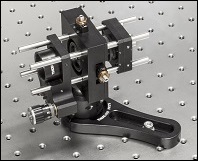
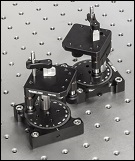
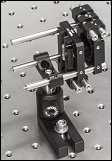

 ピンホールホイール
ピンホールホイール